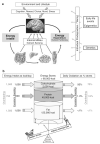Energy metabolism, fuel selection and body weight regulation
- PMID: 19136979
- PMCID: PMC2897177
- DOI: 10.1038/ijo.2008.246
Energy metabolism, fuel selection and body weight regulation
Abstract
Energy homeostasis is critical for the survival of species. Therefore, multiple and complex mechanisms have evolved to regulate energy intake and expenditure to maintain body weight. For weight maintenance, not only does energy intake have to match energy expenditure, but also macronutrient intake must balance macronutrient oxidation. However, this equilibrium seems to be particularly difficult to achieve in individuals with low fat oxidation, low energy expenditure, low sympathetic activity or low levels of spontaneous physical activity, as in addition to excess energy intake, all of these factors explain the tendency of some people to gain weight. Additionally, large variability in weight change is observed when energy surplus is imposed experimentally or spontaneously. Clearly, the data suggest a strong genetic influence on body weight regulation implying a normal physiology in an 'obesogenic' environment. In this study, we also review evidence that carbohydrate balance may represent the potential signal that regulates energy homeostasis by impacting energy intake and body weight. Because of the small storage capacity for carbohydrate and its importance for metabolism in many tissues and organs, carbohydrate balance must be maintained at a given level. This drive for balance may in turn cause increased energy intake when consuming a diet high in fat and low in carbohydrate. If sustained over time, such an increase in energy intake cannot be detected by available methods, but may cause meaningful increases in body weight. The concept of metabolic flexibility and its impact on body weight regulation is also presented.
Figures



Similar articles
-
Spontaneous overfeeding with a 'cafeteria diet' in men: effects on 24-hour energy expenditure and substrate oxidation.Int J Obes Relat Metab Disord. 1995 May;19(5):331-7. Int J Obes Relat Metab Disord. 1995. PMID: 7647825
-
Ad libitum food intake on a "cafeteria diet" in Native American women: relations with body composition and 24-h energy expenditure.Am J Clin Nutr. 1995 Nov;62(5):911-7. doi: 10.1093/ajcn/62.5.911. Am J Clin Nutr. 1995. PMID: 7572735
-
The 24-h carbohydrate oxidation rate in a human respiratory chamber predicts ad libitum food intake.Am J Clin Nutr. 2007 Sep;86(3):625-32. doi: 10.1093/ajcn/86.3.625. Am J Clin Nutr. 2007. PMID: 17823426 Free PMC article.
-
Manipulating carbohydrate content and sources in obesity prone subjects: effect on energy expenditure and macronutrient balance.Int J Obes Relat Metab Disord. 1996 Mar;20 Suppl 2:S24-30. Int J Obes Relat Metab Disord. 1996. PMID: 8646268 Review. No abstract available.
-
Body fat regulation: is it a result of a simple energy balance or a high fat intake?J Am Coll Nutr. 2010 Aug;29(4):343-51. doi: 10.1080/07315724.2010.10719850. J Am Coll Nutr. 2010. PMID: 21041808 Review.
Cited by
-
Serious analytical inconsistencies challenge the validity of the energy balance theory.Heliyon. 2020 Jul 10;6(7):e04204. doi: 10.1016/j.heliyon.2020.e04204. eCollection 2020 Jul. Heliyon. 2020. PMID: 32685707 Free PMC article.
-
The significance of metabolic disease in degenerative cervical myelopathy: a systematic review.Front Neurol. 2024 Feb 5;15:1301003. doi: 10.3389/fneur.2024.1301003. eCollection 2024. Front Neurol. 2024. PMID: 38375465 Free PMC article.
-
Enhancing Health Benefits through Chlorophylls and Chlorophyll-Rich Agro-Food: A Comprehensive Review.Molecules. 2023 Jul 11;28(14):5344. doi: 10.3390/molecules28145344. Molecules. 2023. PMID: 37513218 Free PMC article. Review.
-
Influence of segmental body composition and adiposity hormones on resting metabolic rate and substrate utilization in overweight and obese adults.J Endocrinol Invest. 2017 Jun;40(6):635-643. doi: 10.1007/s40618-017-0616-z. Epub 2017 Feb 16. J Endocrinol Invest. 2017. PMID: 28211029 Free PMC article.
-
Exercise training improves fat metabolism independent of total energy expenditure in sedentary overweight men, but does not restore lean metabolic phenotype.Int J Obes (Lond). 2017 Dec;41(12):1728-1736. doi: 10.1038/ijo.2017.151. Epub 2017 Jul 3. Int J Obes (Lond). 2017. PMID: 28669989
References
-
- Speakman JR. A nonadaptive scenario explaining the genetic predisposition to obesity: the ‘predation release’ hypothesis. Cell Metab. 2007;6:5–12. - PubMed
-
- Obesity: preventing and managing the global epidemic. Report of a WHO consultation. World Health Organ Tech Rep Ser. 2000;894:i–xii. 1–253. - PubMed
-
- Bouchard C. The biological predisposition to obesity: beyond the thrifty genotype scenario. Int J Obes (Lond) 2007;31:1337–1339. - PubMed
-
- Schulz LO, Bennett PH, Ravussin E, Kidd JR, Kidd KK, Esparza J, et al. Effects of traditional and western environments on prevalence of type 2 diabetes in Pima Indians in Mexico and the US. Diabetes Care. 2006;29:1866–1871. - PubMed
Publication types
MeSH terms
Substances
Grants and funding
LinkOut - more resources
Full Text Sources
Other Literature Sources
Medical

